Marketing Channel Comparison for Digital Creatives (2025)
(if you’re on a desktop/laptop, to scroll horizontally – hold [shift] and scroll your mouse)
| Marketing Channel | Best For Creative Type | Time-to-Results | Weekly Time Investment | Implementation Difficulty | 2025 ROI Potential | Effectiveness (Authority/Leads/Sales) | Best Content Format for 2025 | Key Success Metrics |
|---|---|---|---|---|---|---|---|---|
| Email Marketing | Course creators, coaches, digital product sellers | 3-4 months | 6-10 hours | Medium | $36 per $1 spent | High/Very High/Very High | Hyper-personalized newsletters, interactive elements, AI-driven recommendations | Open rate, conversion rate, revenue per subscriber |
| SEO Content | Service providers, consultants, info-product creators | 6-12 months | 10-15 hours | Medium-High | $22 per $1 spent | Very High/High/Medium | Voice-optimized content, local-focused articles, E-E-A-T compliant guides | Organic traffic, keyword rankings |
| Visual artists, designers, photographers | 4-6 months | 8-12 hours | Medium | Medium | Medium/Medium/Low | Carousel albums (highest engagement), Reels, Stories with interactive elements | Saves, shares, profile visits | |
| B2B creatives, consultants, coaches | 3-6 months | 8-12 hours | Medium | High | Very High/High/Medium | Short-form video (2-3x engagement), authentic storytelling (3-5 posts per week) | Post reach, connection growth, profile views | |
| X (Twitter) | Writers, thought leaders, coaches | 2-4 months | 7-10 hours | Low | Medium | Medium/Medium/Low | AI-assisted content, real-time topics (4.2 posts per week for top brands) | Retweets, profile clicks, conversation participation |
| Threads | Brand voice testers, Instagram creators | 2-4 months | 5-8 hours | Low | Low-Medium | Medium/Low/Low | “Unhinged” authentic content, topic tags, bullet-point insights | Engagement rate, follower growth (Gen Z dominated) |
| YouTube | Course creators, coaches, tutorial-based businesses | 6-12 months | 15-25 hours | High | Very High | Very High/High/High | Short-form video (Shorts), videos timed for peak hours (6 PM to 9 PM) | Watch time, subscriber growth, Super Chat revenue |
| Podcast | Coaches, consultants, thought leaders | 6-9 months | 10-20 hours | Medium-High | High | High/Medium/Medium | High-quality production with unique angles, bite-sized episodes (10-15 min) | Download growth, guest booking success, listener reviews |
| Webinars | Course creators, high-ticket service providers | 1-2 months | 15-20 hours (per webinar) | Medium | Very High | High/Very High/Very High | Interactive Q&As, live demonstrations, exclusive offers | Registration-to-attendee ratio, sales conversion rate |
| Digital product sellers, visual content creators | 3-6 months | 6-10 hours | Medium | High | Medium/High/Medium | Idea pins, shopping pins, SEO-optimized descriptions | Click-through rate, saves, website traffic | |
| Facebook/Discord Community | Membership site owners, course creators | 6-12 months | 10-15 hours | Medium | Medium-High | Medium/High/High | Live sessions, exclusive content, interactive discussions | Active member ratio, engagement rate, membership retention |
| TikTok | Coaches, digital product sellers | 2-3 months | 8-12 hours | Medium | Medium | Medium/High/Medium | Educational micro-content, behind-the-scenes, trending sounds/challenges | Video completion rate, follower growth rate |
| Paid Advertising | Product launches, event promotion | Immediate | 8-12 hours | Medium-High | 5-20x ROAS | Low/Very High/High | Video testimonials, interactive formats, platform-native creative | ROAS, cost per acquisition, conversion rate |
If you’re a creative trying to market your digital products, courses, or coaching services, know which marketing channels are worth your time. The table above helps you quickly see which options make the most sense for your specific creative business.
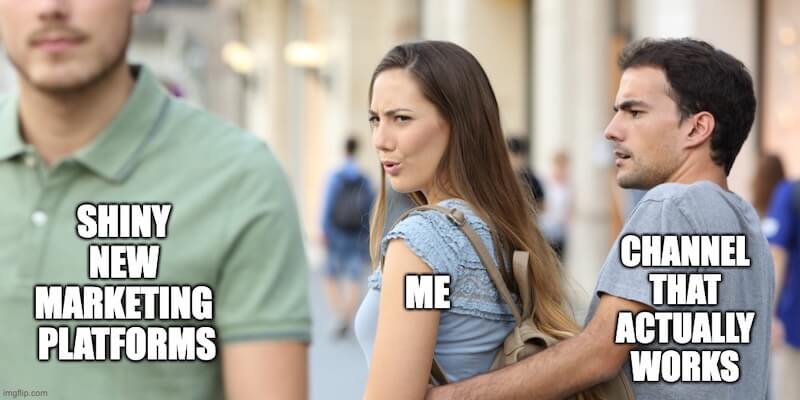
Takeaways
Email Marketing: Delivering $36 ROI per $1 spent with hyper-personalization and interactive elements driving engagement (Source: Litmus)
SEO: Driving 14.6% close rates compared to 1.7% for outbound marketing, with $86.7B market size in 2025 (Source: Search Engine Journal)
Instagram: Shifting focus from follower count to saves and shares as primary engagement metrics (Source: Empowered Artists)
LinkedIn: 90% of CMOs now demanding bolder B2B content with higher creative quality (Source: LinkedIn)
YouTube: Niche communities and micro-audiences delivering higher engagement than broad content (Source: Upfluence)
Unhinged Content: Many folks prefer “unhinged” authentic marketing instead of polished corporate content (Source: Campaign Brief)
How to Use This Table
Identify 1-2 channels that align with your creative business type and audience
Consider your available time and technical skill constraints
Start with the channel offering best ROI for your specific goals (authority, leads, or sales)
Master 1 primary channel before expanding to complementary platforms
Track the listed success metrics to evaluate and optimize performance
–
Your Creative Brand Identity
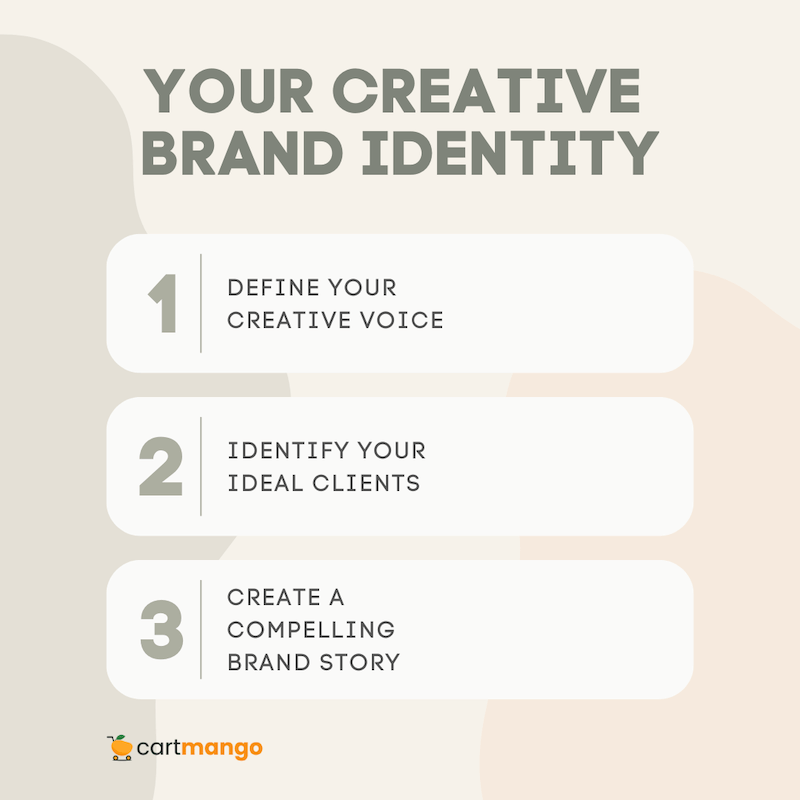
Before jumping into marketing tactics, clarity on who you are as a creative brand.
Define your creative voice
What makes your teaching style, coaching approach, or digital products different? This goes beyond your logo and colors. Your voice includes your communication style, values, and the specific way you solve problems.
Identify your ideal clients
Get super specific about who benefits most from your creative services. What problems do they face? What goals do they have? What language do they use to describe their challenges?
Create a compelling brand story
People connect with stories, not features.
Share why you started your creative business, what challenges you’ve overcome, and how you help others transform.
In a 2024 Sprout Social study, 70% of consumers reported feeling more connected to brands that share authentic stories about their journey.
Your brand identity should flow naturally into how you present yourself across all marketing channels. This consistency builds trust and recognition with potential clients.
–
Marketing Strategies for Solo Course Creators
Creating an online course is just the first step. Getting students to find and buy your course requires targeted marketing efforts.
Craft compelling course previews
Include short video samples that show your teaching style and give a taste of what students will learn. Free previews can increase conversion rates.
Use mini-courses as lead magnets
Create a free 10-20 minute version of your course that solves one specific problem. This gives potential students a chance to experience your teaching style.
Optimize for mobile learning
Make sure your course materials look good on phones and tablets. Statista reports that mobile learning now accounts for 67% of course consumption.
Host regular webinars
Live training sessions convert better than any other marketing method for courses.
–
Marketing Approaches for Solo Coaches
Coaching is a relationship business, so your marketing should build trust and showcase your expertise.
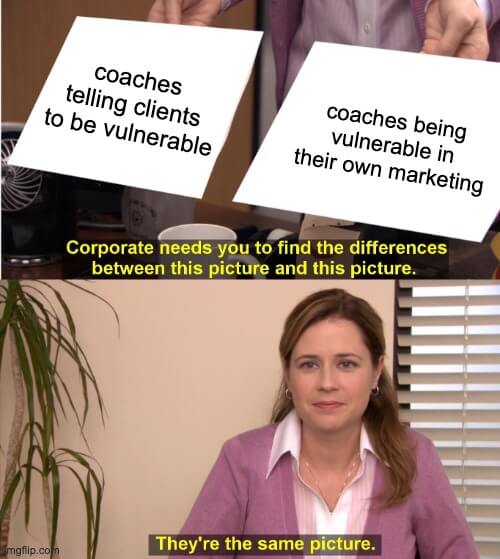
Communicate your unique approach
What coaching philosophy sets you apart?
How do you work with clients?
Be clear about your process, not just the outcomes.
Coaches who clearly explain their methodology usually convert better than those who focus only on results.
Build authority through content
Share helpful advice through blogs, videos, or podcasts.
Jay Shetty grew his coaching business to multiple seven figures by consistently publishing valuable content before asking for sales.
Create compelling coaching packages
Structure your offerings in clear tiers that solve specific problems. Having three distinct package options can increase your revenue.
Collect and showcase testimonials
Client success stories are your most powerful marketing tool. Marie Forleo features in-depth client testimonials throughout her B-School coaching program marketing.
Set up referral systems
Make it easy for satisfied clients to refer others to you. Offer incentives for successful referrals, such as session credits or resources.
–
Marketing for Service Providers
Service providers like designers, writers, and consultants need to market differently than product sellers.
Define clear service packages
Package your creative services into clear offerings with defined deliverables, timelines, and prices. Service providers with packaged offerings usually earn more than those with customized-only services.
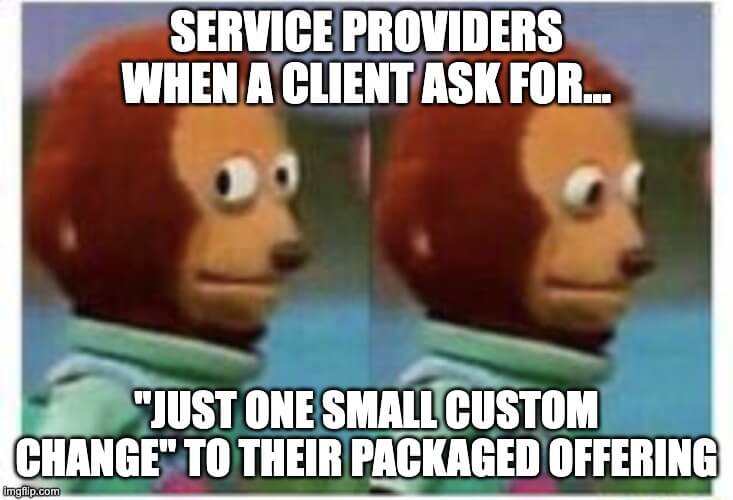
Explain your process
Show examples of your work, including the process behind it. This will attract clients who value your approach, rather than just folks who just want the end results.
Attract ideal clients with targeted content
Create blog posts, videos, or resources that address the specific problems your ideal clients face. This positions you as an expert and draws in qualified leads.
Communicate your value clearly
Don’t just list features; explain how your services help clients achieve their goals.
What transformation do you provide?
What problems do you solve?
Build simple conversion funnels
Map out how potential clients move from discovering you to hiring you. Each step should bring them closer to working with you.
–
Tools for Solo Digital Creatives
The right tools can make marketing much easier for busy creative entrepreneurs.
Cart/checkout: CartMango is designed specifically for solo creators selling digital products. Setting up offers takes just one minute, and it’s free throughout 2025.
AI tools for content creation. Use Jasper for writing assistance, Descript for video and audio editing, and Synthesia for creating video content without appearing on camera.
Design and content tools. Canva remains the go-to for creating professional graphics, while Loom makes it easy to record quick videos for clients or students.
Social media management. Buffer and Hootsuite help you schedule social media posts across platforms, saving hours of time each week. Both offer analytics to see what content performs best.
Analytics and tracking. Google Analytics helps you understand website traffic.
Email marketing: Unlike general platforms, BirdSend is specifically built for course creators and coaches. It focuses on deliverability and costs a lot less than platforms like ConvertKit or Mailchimp.
–
Building a Marketing System as a Solo Creative
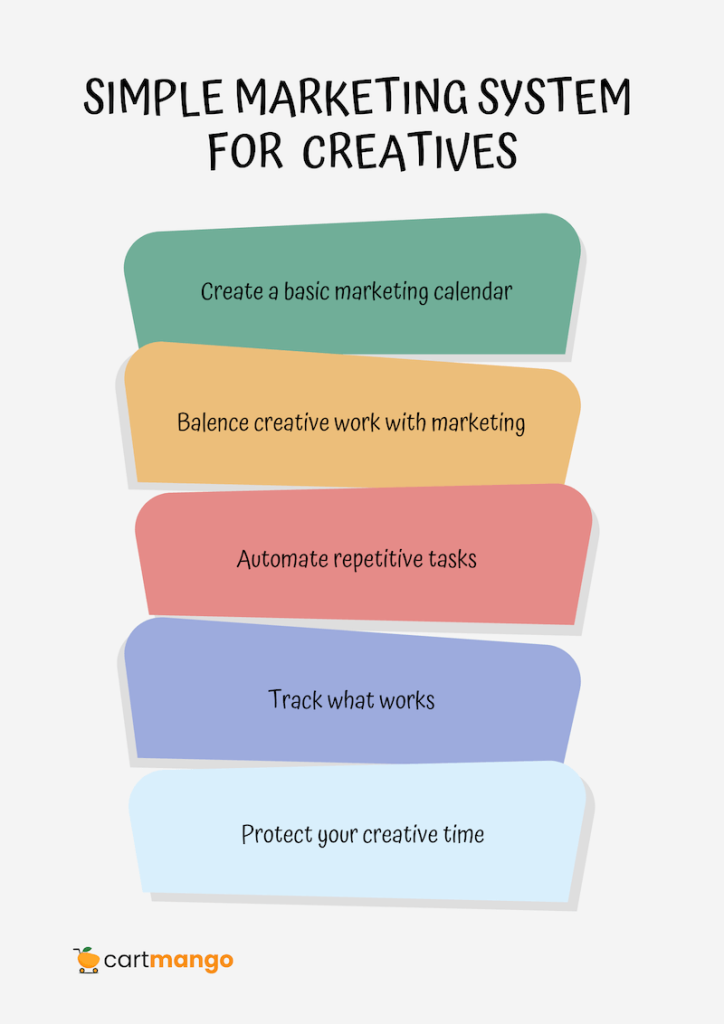
Random marketing efforts lead to random results. You need a simple system.
Create a basic marketing calendar
Plan your content and promotions at least one month in advance. Focus on just 1-2 platforms rather than trying to be everywhere.
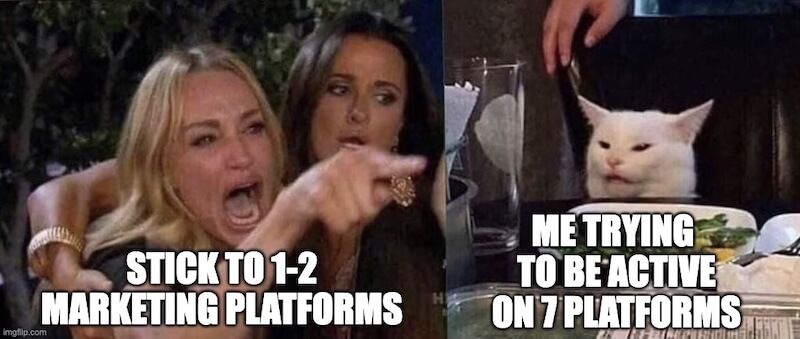
Balance creative work with marketing
Block specific times for marketing activities in your calendar. Try the 80/20 approach: spend 80% of your time creating and 20% promoting.
Automate repetitive tasks
Use tools like Zapier or Make to connect your platforms and automate workflows. This saves hours of manual work each week.
Track what works
Review your metrics monthly to see which marketing efforts bring in clients or sales. Double down on what works and cut what doesn’t.
Protect your creative time
Block focused work sessions and prevent meeting overload. This ensures you have energy for both creating and marketing.
–
Common Challenges
Many creatives struggle with marketing because it feels pushy or inauthentic.
Create human-centered content
Focus on being helpful rather than promotional. Answer questions your audience has and provide genuine value.
Market in ways that feel good to you
If you hate making videos, don’t build a YouTube strategy.
Play to your strengths
Use your creative skills as marketing assets. Showcase your process, not just the final product.
Focus on connection over conversion
Build relationships first, sell second.
Be consistent rather than perfect
Regular, helpful content builds an audience more effectively than occasional perfect pieces.
Done is better than perfect.
–
Connecting Through Authentic Content
Find your target audience where they hang out
Instagram Stories are perfect for showing the behind-the-scenes of your creative process. Many successful creators started writing daily Stories posts before expanding to other formats.
Share personal glimpses of your world
Networking doesn’t always mean formal business events. Sometimes sharing bits of your life helps potential clients connect with you on a human level.
Work hard on content that matters
When you introduce topics that genuinely interest you, your enthusiasm comes through. This makes your content more interesting to your audience.
Encourage creativity in your marketing
The power of authentic content lies in how it makes people respond. Whether you’re creating a free guide or filming a quick tutorial, your confidence shows when you’re being genuine.
You don’t necessarily need to engage with every platform. Focus on where your ideal clients spend their time. Many creative entrepreneurs are concerned about spreading themselves too thin across the web and the entire industry.
This approach works because creativity in marketing isn’t just about fancy graphics or clever words. It’s about connecting what you do to real people’s lives in ways that matter to them.
–
Success Stories from Solo Creatives
Learning from real examples helps you see what’s possible for your own creative business.
Walking Through Mud for 5 Years: Jay Clouse
Jay Clouse started his business back in 2017, working from Ohio. His first years weren’t easy – he describes this time as “walking through mud for 5 years.” But today, his business Creator Science brings in about $40,000 every month.
Before finding success, Jay tried different ventures. He co-founded Tixers, an events marketplace, and built Unreal Collective, which he later sold to Pat Flynn of Smart Passive Income. These early experiences taught him valuable lessons about what works and what doesn’t.
In March 2022, Jay launched “The Lab,” a membership community for serious creators who already have some success. He keeps it small on purpose – just 200 members. Each member pays a premium price, bringing in between $400,000-$500,000 yearly from this community alone.
Jay built his audience steadily over time. His newsletter now reaches over 50,000 readers. His YouTube channel has grown past 100,000 subscribers. His podcast has been downloaded more than 2 million times.
What makes Jay’s approach different is how he focuses on helping established creators improve their businesses. Instead of chasing viral success, he tests different approaches and shares what actually works. In 2024, he launched CreatorHQ, a ready-to-use Notion setup for creators to organize their business.
Source: Starter Story, Community Inc
–
Anne-Laure Le Cunff: From Burnout to Building Ness Labs
Anne-Laure used to work at Google, but she got very tired from working too hard.
Instead of finding another big company job, she decided to start her own project called Ness Labs.
She began by writing articles about how our brains work and how to be productive without getting stressed. She challenged herself to write 100 articles in 100 days. This helped her get 6,000 people to sign up for her newsletter.
Today, more than 75,000 people read her newsletter. She also runs a community where people pay $49 each year to join. Over 2,500 people have paid to be part of this group.
What makes Anne-Laure special is that she shares everything she learns. She doesn’t just show the finished product – she shows how she makes things. It’s like letting people see inside her workshop while she’s building.
When she started making money, she tried getting companies to pay to advertise in her newsletter. But sometimes many companies wanted to advertise, and sometimes none did. To make her income more steady, she created her membership community in March 2020.
Anne-Laure is also going to school to learn more about how our brains work. She’s studying for a PhD in Neuroscience at King’s College London. This shows that you can build a business while still learning new things.
Her website now gets about 200,000 visits each month from Google searches. This happened because she wrote helpful articles that answer questions people have.
The main lesson from Anne-Laure’s story is that doing small, consistent actions (like writing articles regularly) can grow into something big over time.
Source: Embarque, Growth In Reverse, Balance The Grind
–
Marketing For Creatives: What Next?
Marketing your creative business doesn’t need to be complicated or uncomfortable.
Choose ONE-TWO marketing channels from the comparison table
Create 2-4 pieces of helpful content for that channel each week
Set up an email collection system on your website
Track which content gets the most sales
After 60-90 days, review and adjust based on results
The most successful creative entrepreneurs view marketing as an extension of their creative work—another way to help their audience. By focusing on value and authenticity, your marketing becomes less about selling and more about connecting.
Related
- SendOwl vs Gumroad: The Recurring Revenue Black Hole (2026)
- Gumroad vs Sellfy: The Vendor Lock-in Cage (2025)
- Gumroad vs Payhip: The Hidden Trap for Creators (2025)
- ThriveCart vs SamCart – The Subscription Hostage Trap (2025)
- 8 ThriveCart Alternatives & The Lifetime Pricing Paradox (2025)
- 8 SamCart alternatives + Subscription hostage (2025)
- The GENTLE Method: Soft marketing for creators
- How Far in Advance Should You Promote a Webinar?
- The SAVINGS Method: The Productivity Improvement Plan for Creators
- 9 Questions to Ask: How to Hire a Digital Marketing Agency
